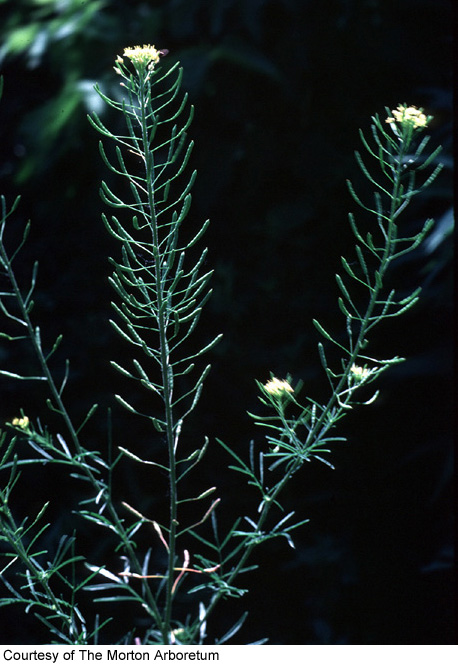- Home
- Search
- Images
- Datasets
- Sample Use
- How to Cite
- Additional Information
- About NEON
- NEON Data Portal
- ASU Biocollections
- About Symbiota
|
|
|
|
Family: Brassicaceae
wormseed wallflower
[Cheirinia cheiranthoides (L.) Link] |
Annuals. Trichomes of leaves primarily 3- or 4-rayed, some-times mixed with 5-rayed ones, 2-rayed trichomes primarily on stem and pedicels. Stems erect, often branched distally, (ribbed), (0.7-)1.5-10(-15) dm. Basal leaves (withered by fruiting), similar to cauline. Cauline leaves: (median and distal) shortly petiolate or sessile; blade (lanceolate, linear, or elliptic-oblong, (1-)2-7(-11) cm × (2-)5-12 (-23) mm, base cuneate) margins usually subentire or denticulate, rarely sinuate-dentate, (apex acute or obtuse). Racemes considerably elongated in fruit. Fruiting pedicels divaricate or ascending, slender, much narrower than fruit, 5-13(-16) mm. Flowers: sepals oblong, 1.8-3.2 mm, lateral pair not saccate basally; petals yellow, narrowly spatulate, 3-5.5 × 1.5-2 mm, claw 1.5-3.5 mm, apex rounded; median filaments 2-3.5 mm; anthers oblong, 0.5-0.7 mm. Fruits suberect or divaricate-ascending, linear, straight, somewhat torulose, (1-)1.5-2.5(-4) cm × 1-1.3 mm, 4-angled, not striped; valves with prominent midvein, pubescent outside, trichomes 3-5-rayed, densely pubescent inside; ovules (20-)30-55 per ovary; style cylindrical, slender, 0.5-1.5 mm; stigma entire or slightly 2-lobed, lobes as long as wide. Seeds oblong, 1-1.5 × 0.4-0.6 mm; not winged. 2n = 16. Flowering Jun-Aug. Dry stream beds, moist areas, waste ground, fields, pastures, disturbed ground; 0-3000 m; introduced; Alta., B.C., Man., N.B., Nfld. and Labr. (Nfld.), N.W.T., N.S., Nunavut, Ont., P.E.I., Que., Sask., Yukon; Alaska, Ark., Calif., Colo., Conn., D.C., Fla., Idaho, Ill., Ind., Iowa, Kans., Maine, Md., Mass., Mich., Minn., Mo., Mont., Nebr., Nev., N.H., N.J., N.Mex., N.Y., N.C., N.Dak., Ohio, Oreg., Pa., R.I., S.Dak., Tenn., Utah, Vt., Va., Wash., W.Va., Wis., Wyo.; Europe; Asia; n Africa. Annual herb 20 cm - 1 m tall Stem: upright, usually unbranched, very hairy. Leaves: alternate, linear to oblong, mostly non-toothed, and hairy. Flowers: in a long, dense, branched cluster (raceme). Stalks widely spreading, slender, 6 - 14 mm long. Sepals four, 2 - 3.5 mm long. Petals four, pale to bright yellow, 3.5 - 5 mm long. Stamens six. Fruit: a long, narrow pod, upright to ascending, 1.2 - 3 cm long, four-angled, and hairy. Seeds in one row. Similar species: The similar Erysimum hieraciifolium, E. inconspicuum, and E. repandum differ by having petals that exceed 5 mm long, sepals that exceed 3.5 mm long, and fruit that exceeds 3 cm long. Flowering: mid-May to early September Habitat and ecology: Introduced from Eurasia. In the Chicago Region, this is an uncommon but widespread weed of nitrogen-rich soils. It has become naturalized in many disturbed areas such as along roads, railroads, and in fields. Also found in barnyards, cultivated ground, and areas where grain has been accidentally scattered. Occurence in the Chicago region: non-native Etymology: Erysimum comes from the Greek word eryomai, meaning "to help or save," which refers to the medicinal qualities of some species. Cheiranthoides means "like Cheiranthus," which is the genus name for the wallflower. Author: The Morton Arboretum Erect, often simple annual 2-10 dm; lvs linear to oblanceolate, entire or barely sinuate; sep 2-3.5 mm; pet bright yellow, 3.5-5.5 mm; mature racemes elongate, with straight rachis and slender, widely divergent pedicels (6-)8-12(-14) mm; frs ascending to erect, (1.2-)1.5-2.5(-3) cm; 2n=16. Usually in wet soil, but also a weed in fields and roadsides; originally European, but now circumboreal, s. in Amer. to N.C., Ark., Colo., and Oreg. June- Aug. (Cheirinia c.) Gleason, Henry A. & Cronquist, Arthur J. 1991. Manual of vascular plants of northeastern United States and adjacent Canada. lxxv + 910 pp. ©The New York Botanical Garden. All rights reserved. Used by permission. |
|
|
|


